Organizational Culture Analysis: A Report on Tesco (MG414)
VerifiedAdded on 2022/12/12
|10
|2829
|402
Report
AI Summary
This report provides a comprehensive analysis of Tesco's organizational culture, examining its key components and impact on organizational effectiveness. The report begins with an executive summary and table of contents, followed by an introduction that highlights the significance of organizational culture in shaping employee behavior and overall company performance. The secondary research section explores relevant theories and models, including Handy's culture theory, Edgar Schein's culture theory, and various communication models like the Interactional Model and Lasswell's Model. The report also delves into motivation theories, such as Maslow's hierarchy of needs and Herzberg's two-factor theory, to understand their influence on employee behavior and satisfaction within Tesco. Furthermore, the report includes primary research in the form of interviews with Tesco managers, providing insights into the practical application of cultural theories, communication models, and motivation strategies within the organization. The findings from the interviews are presented, offering a real-world perspective on Tesco's organizational culture. Finally, the report concludes by summarizing the key findings and offering recommendations on how Tesco can leverage its organizational culture to enhance its success.
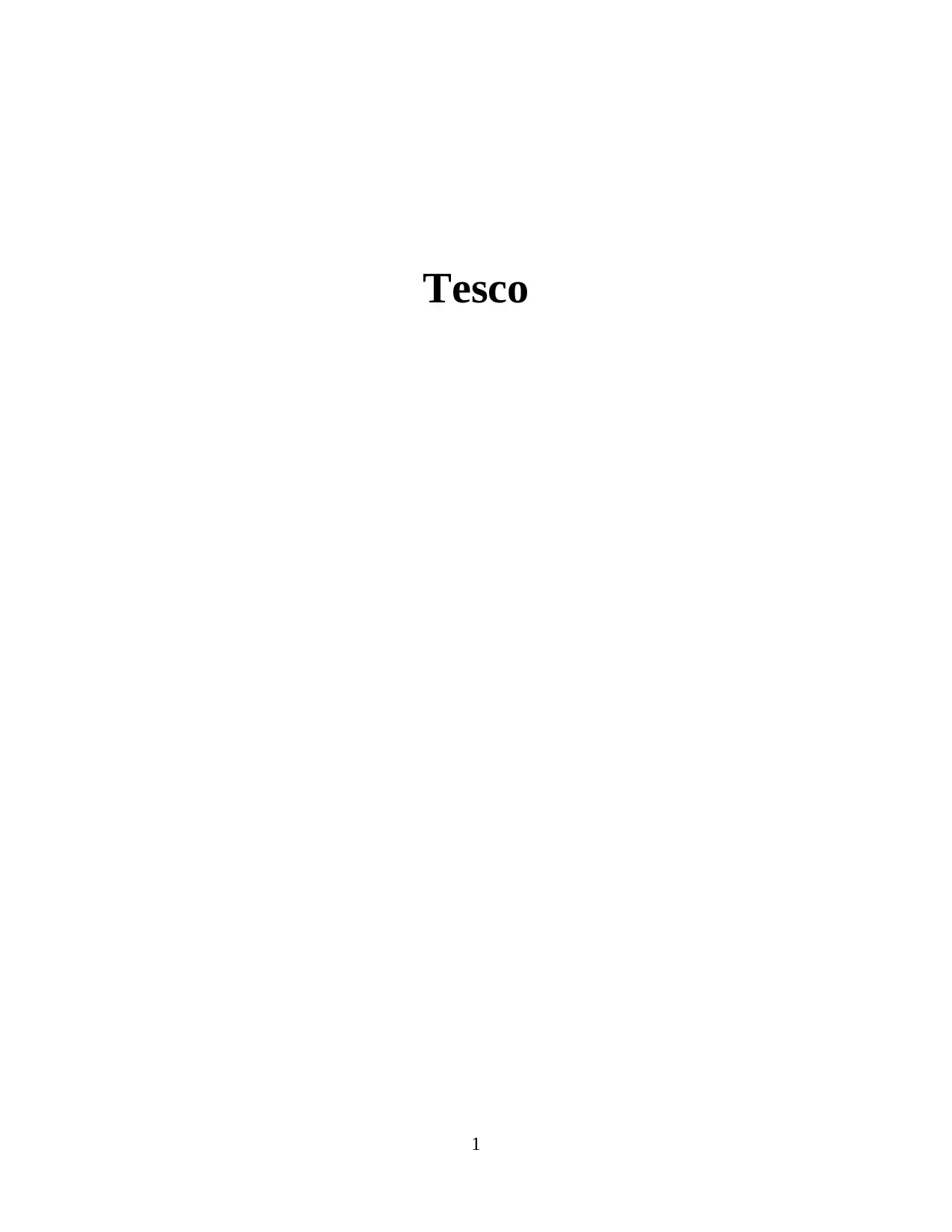
Tesco
1
1
Paraphrase This Document
Need a fresh take? Get an instant paraphrase of this document with our AI Paraphraser
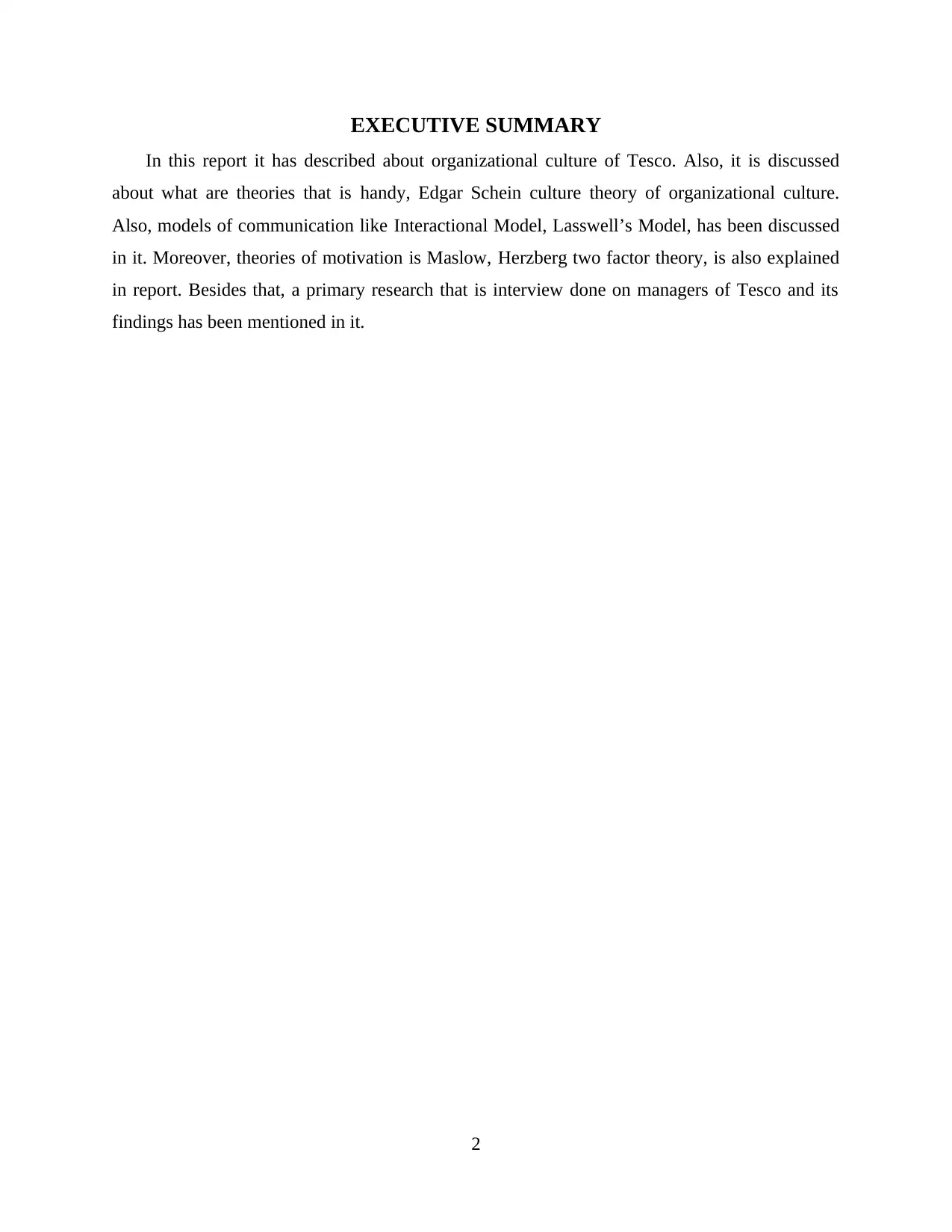
EXECUTIVE SUMMARY
In this report it has described about organizational culture of Tesco. Also, it is discussed
about what are theories that is handy, Edgar Schein culture theory of organizational culture.
Also, models of communication like Interactional Model, Lasswell’s Model, has been discussed
in it. Moreover, theories of motivation is Maslow, Herzberg two factor theory, is also explained
in report. Besides that, a primary research that is interview done on managers of Tesco and its
findings has been mentioned in it.
2
In this report it has described about organizational culture of Tesco. Also, it is discussed
about what are theories that is handy, Edgar Schein culture theory of organizational culture.
Also, models of communication like Interactional Model, Lasswell’s Model, has been discussed
in it. Moreover, theories of motivation is Maslow, Herzberg two factor theory, is also explained
in report. Besides that, a primary research that is interview done on managers of Tesco and its
findings has been mentioned in it.
2
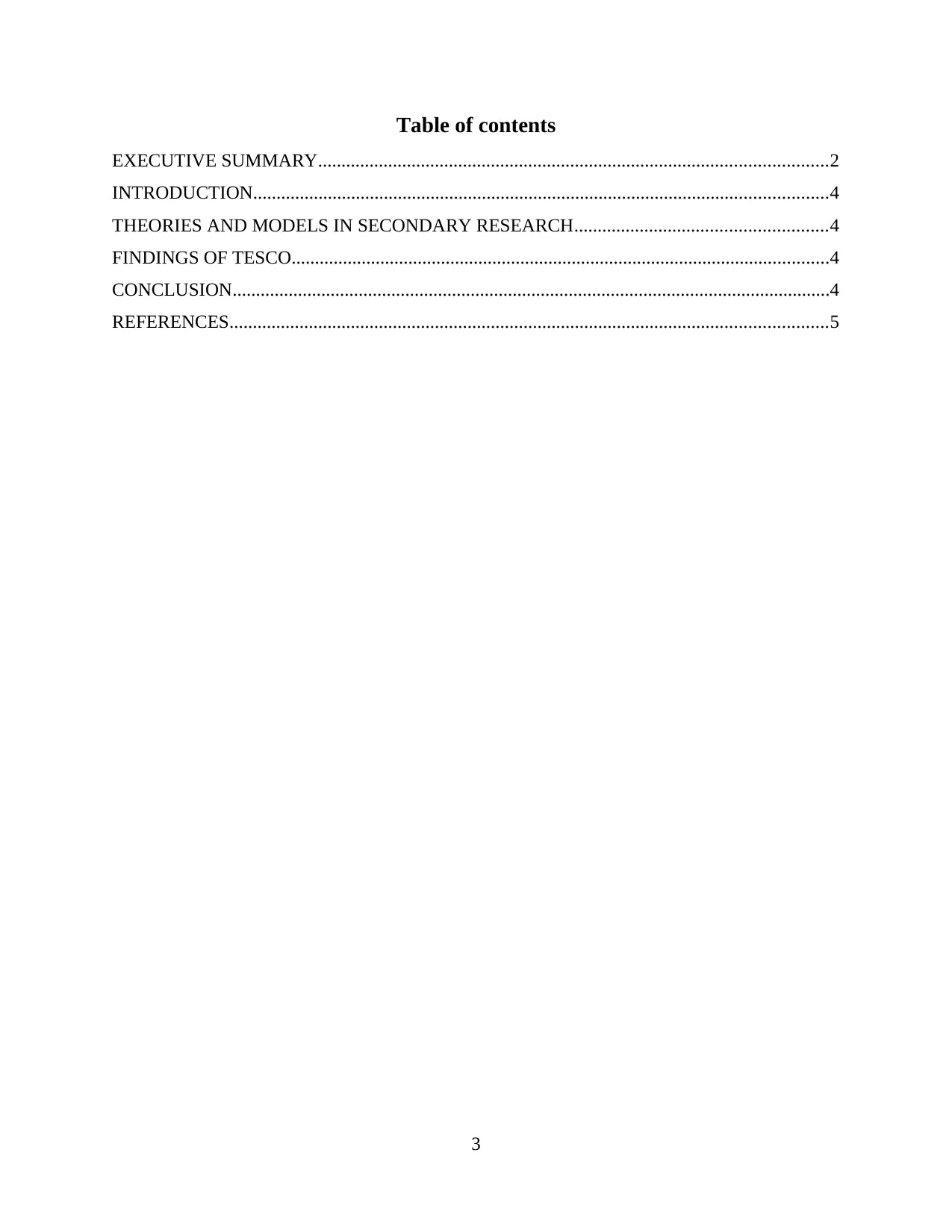
Table of contents
EXECUTIVE SUMMARY.............................................................................................................2
INTRODUCTION...........................................................................................................................4
THEORIES AND MODELS IN SECONDARY RESEARCH......................................................4
FINDINGS OF TESCO...................................................................................................................4
CONCLUSION................................................................................................................................4
REFERENCES................................................................................................................................5
3
EXECUTIVE SUMMARY.............................................................................................................2
INTRODUCTION...........................................................................................................................4
THEORIES AND MODELS IN SECONDARY RESEARCH......................................................4
FINDINGS OF TESCO...................................................................................................................4
CONCLUSION................................................................................................................................4
REFERENCES................................................................................................................................5
3
⊘ This is a preview!⊘
Do you want full access?
Subscribe today to unlock all pages.

Trusted by 1+ million students worldwide
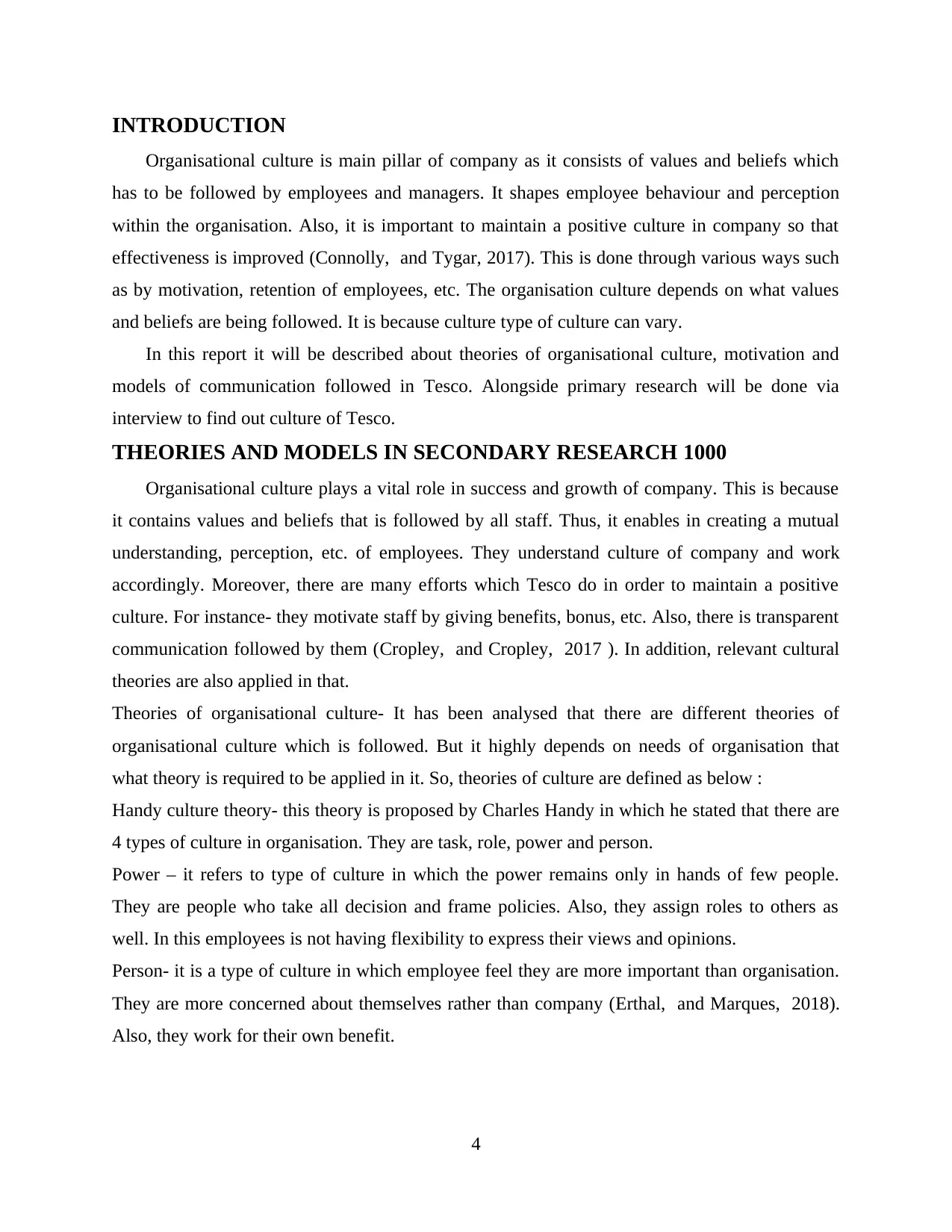
INTRODUCTION
Organisational culture is main pillar of company as it consists of values and beliefs which
has to be followed by employees and managers. It shapes employee behaviour and perception
within the organisation. Also, it is important to maintain a positive culture in company so that
effectiveness is improved (Connolly, and Tygar, 2017). This is done through various ways such
as by motivation, retention of employees, etc. The organisation culture depends on what values
and beliefs are being followed. It is because culture type of culture can vary.
In this report it will be described about theories of organisational culture, motivation and
models of communication followed in Tesco. Alongside primary research will be done via
interview to find out culture of Tesco.
THEORIES AND MODELS IN SECONDARY RESEARCH 1000
Organisational culture plays a vital role in success and growth of company. This is because
it contains values and beliefs that is followed by all staff. Thus, it enables in creating a mutual
understanding, perception, etc. of employees. They understand culture of company and work
accordingly. Moreover, there are many efforts which Tesco do in order to maintain a positive
culture. For instance- they motivate staff by giving benefits, bonus, etc. Also, there is transparent
communication followed by them (Cropley, and Cropley, 2017 ). In addition, relevant cultural
theories are also applied in that.
Theories of organisational culture- It has been analysed that there are different theories of
organisational culture which is followed. But it highly depends on needs of organisation that
what theory is required to be applied in it. So, theories of culture are defined as below :
Handy culture theory- this theory is proposed by Charles Handy in which he stated that there are
4 types of culture in organisation. They are task, role, power and person.
Power – it refers to type of culture in which the power remains only in hands of few people.
They are people who take all decision and frame policies. Also, they assign roles to others as
well. In this employees is not having flexibility to express their views and opinions.
Person- it is a type of culture in which employee feel they are more important than organisation.
They are more concerned about themselves rather than company (Erthal, and Marques, 2018).
Also, they work for their own benefit.
4
Organisational culture is main pillar of company as it consists of values and beliefs which
has to be followed by employees and managers. It shapes employee behaviour and perception
within the organisation. Also, it is important to maintain a positive culture in company so that
effectiveness is improved (Connolly, and Tygar, 2017). This is done through various ways such
as by motivation, retention of employees, etc. The organisation culture depends on what values
and beliefs are being followed. It is because culture type of culture can vary.
In this report it will be described about theories of organisational culture, motivation and
models of communication followed in Tesco. Alongside primary research will be done via
interview to find out culture of Tesco.
THEORIES AND MODELS IN SECONDARY RESEARCH 1000
Organisational culture plays a vital role in success and growth of company. This is because
it contains values and beliefs that is followed by all staff. Thus, it enables in creating a mutual
understanding, perception, etc. of employees. They understand culture of company and work
accordingly. Moreover, there are many efforts which Tesco do in order to maintain a positive
culture. For instance- they motivate staff by giving benefits, bonus, etc. Also, there is transparent
communication followed by them (Cropley, and Cropley, 2017 ). In addition, relevant cultural
theories are also applied in that.
Theories of organisational culture- It has been analysed that there are different theories of
organisational culture which is followed. But it highly depends on needs of organisation that
what theory is required to be applied in it. So, theories of culture are defined as below :
Handy culture theory- this theory is proposed by Charles Handy in which he stated that there are
4 types of culture in organisation. They are task, role, power and person.
Power – it refers to type of culture in which the power remains only in hands of few people.
They are people who take all decision and frame policies. Also, they assign roles to others as
well. In this employees is not having flexibility to express their views and opinions.
Person- it is a type of culture in which employee feel they are more important than organisation.
They are more concerned about themselves rather than company (Erthal, and Marques, 2018).
Also, they work for their own benefit.
4
Paraphrase This Document
Need a fresh take? Get an instant paraphrase of this document with our AI Paraphraser
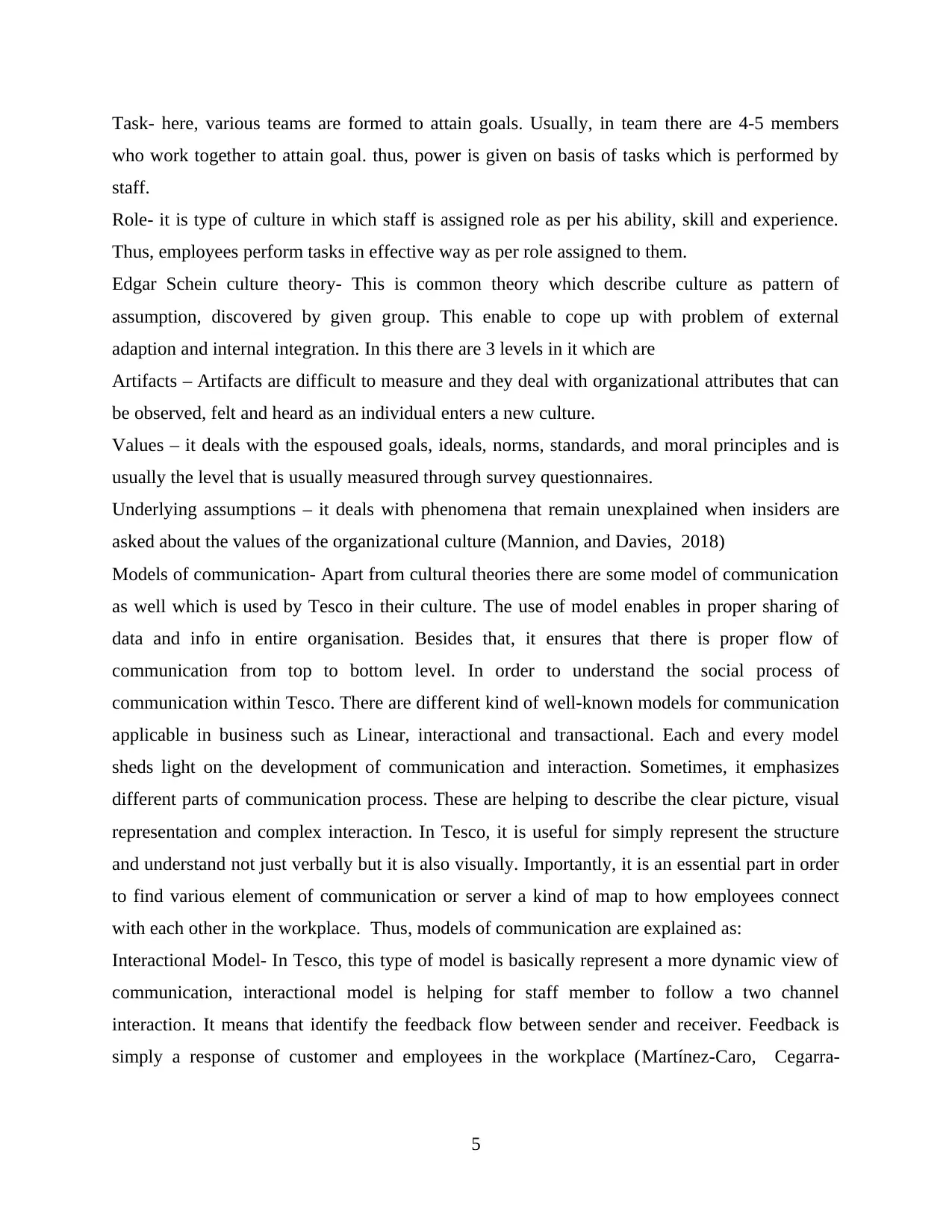
Task- here, various teams are formed to attain goals. Usually, in team there are 4-5 members
who work together to attain goal. thus, power is given on basis of tasks which is performed by
staff.
Role- it is type of culture in which staff is assigned role as per his ability, skill and experience.
Thus, employees perform tasks in effective way as per role assigned to them.
Edgar Schein culture theory- This is common theory which describe culture as pattern of
assumption, discovered by given group. This enable to cope up with problem of external
adaption and internal integration. In this there are 3 levels in it which are
Artifacts – Artifacts are difficult to measure and they deal with organizational attributes that can
be observed, felt and heard as an individual enters a new culture.
Values – it deals with the espoused goals, ideals, norms, standards, and moral principles and is
usually the level that is usually measured through survey questionnaires.
Underlying assumptions – it deals with phenomena that remain unexplained when insiders are
asked about the values of the organizational culture (Mannion, and Davies, 2018)
Models of communication- Apart from cultural theories there are some model of communication
as well which is used by Tesco in their culture. The use of model enables in proper sharing of
data and info in entire organisation. Besides that, it ensures that there is proper flow of
communication from top to bottom level. In order to understand the social process of
communication within Tesco. There are different kind of well-known models for communication
applicable in business such as Linear, interactional and transactional. Each and every model
sheds light on the development of communication and interaction. Sometimes, it emphasizes
different parts of communication process. These are helping to describe the clear picture, visual
representation and complex interaction. In Tesco, it is useful for simply represent the structure
and understand not just verbally but it is also visually. Importantly, it is an essential part in order
to find various element of communication or server a kind of map to how employees connect
with each other in the workplace. Thus, models of communication are explained as:
Interactional Model- In Tesco, this type of model is basically represent a more dynamic view of
communication, interactional model is helping for staff member to follow a two channel
interaction. It means that identify the feedback flow between sender and receiver. Feedback is
simply a response of customer and employees in the workplace (Martínez-Caro, Cegarra-
5
who work together to attain goal. thus, power is given on basis of tasks which is performed by
staff.
Role- it is type of culture in which staff is assigned role as per his ability, skill and experience.
Thus, employees perform tasks in effective way as per role assigned to them.
Edgar Schein culture theory- This is common theory which describe culture as pattern of
assumption, discovered by given group. This enable to cope up with problem of external
adaption and internal integration. In this there are 3 levels in it which are
Artifacts – Artifacts are difficult to measure and they deal with organizational attributes that can
be observed, felt and heard as an individual enters a new culture.
Values – it deals with the espoused goals, ideals, norms, standards, and moral principles and is
usually the level that is usually measured through survey questionnaires.
Underlying assumptions – it deals with phenomena that remain unexplained when insiders are
asked about the values of the organizational culture (Mannion, and Davies, 2018)
Models of communication- Apart from cultural theories there are some model of communication
as well which is used by Tesco in their culture. The use of model enables in proper sharing of
data and info in entire organisation. Besides that, it ensures that there is proper flow of
communication from top to bottom level. In order to understand the social process of
communication within Tesco. There are different kind of well-known models for communication
applicable in business such as Linear, interactional and transactional. Each and every model
sheds light on the development of communication and interaction. Sometimes, it emphasizes
different parts of communication process. These are helping to describe the clear picture, visual
representation and complex interaction. In Tesco, it is useful for simply represent the structure
and understand not just verbally but it is also visually. Importantly, it is an essential part in order
to find various element of communication or server a kind of map to how employees connect
with each other in the workplace. Thus, models of communication are explained as:
Interactional Model- In Tesco, this type of model is basically represent a more dynamic view of
communication, interactional model is helping for staff member to follow a two channel
interaction. It means that identify the feedback flow between sender and receiver. Feedback is
simply a response of customer and employees in the workplace (Martínez-Caro, Cegarra-
5
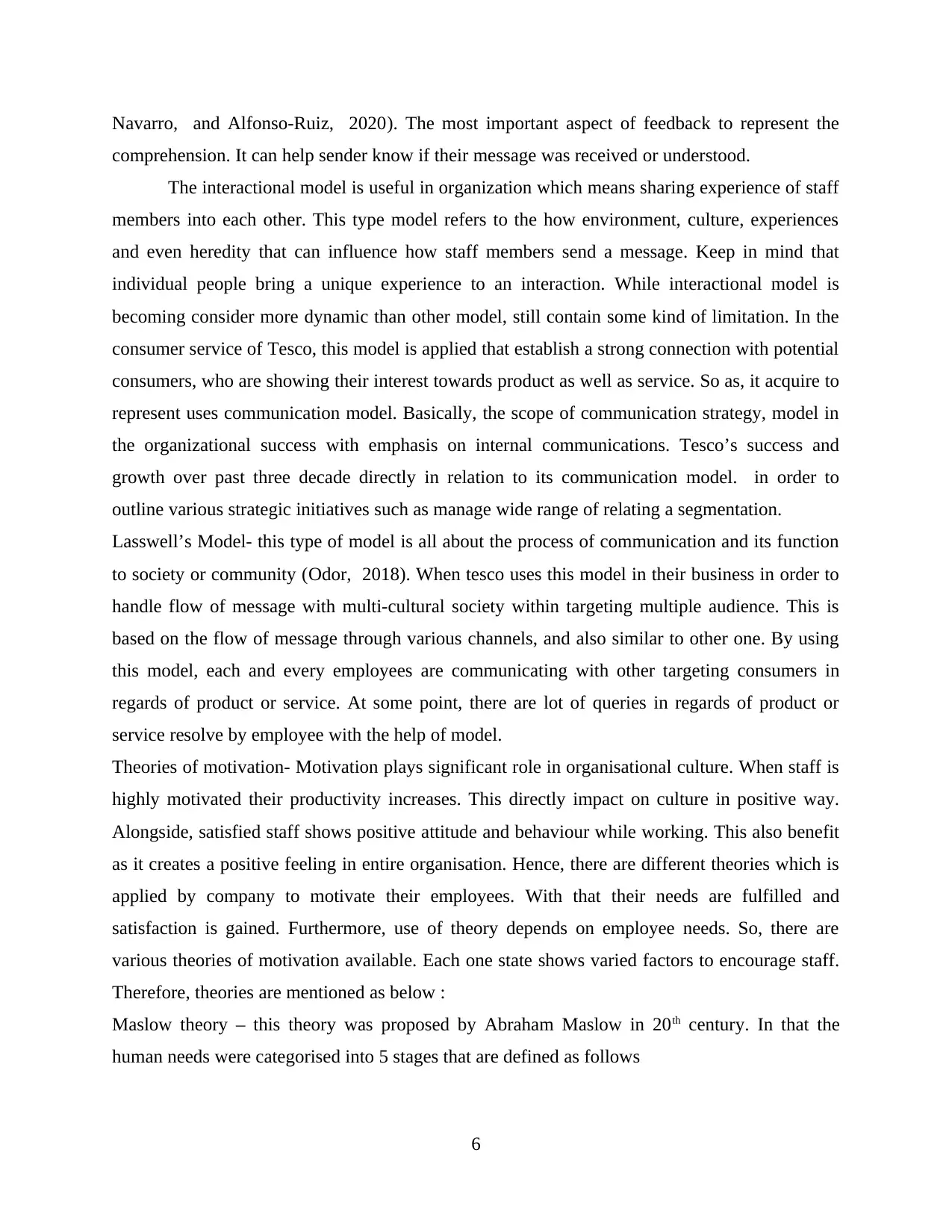
Navarro, and Alfonso-Ruiz, 2020). The most important aspect of feedback to represent the
comprehension. It can help sender know if their message was received or understood.
The interactional model is useful in organization which means sharing experience of staff
members into each other. This type model refers to the how environment, culture, experiences
and even heredity that can influence how staff members send a message. Keep in mind that
individual people bring a unique experience to an interaction. While interactional model is
becoming consider more dynamic than other model, still contain some kind of limitation. In the
consumer service of Tesco, this model is applied that establish a strong connection with potential
consumers, who are showing their interest towards product as well as service. So as, it acquire to
represent uses communication model. Basically, the scope of communication strategy, model in
the organizational success with emphasis on internal communications. Tesco’s success and
growth over past three decade directly in relation to its communication model. in order to
outline various strategic initiatives such as manage wide range of relating a segmentation.
Lasswell’s Model- this type of model is all about the process of communication and its function
to society or community (Odor, 2018). When tesco uses this model in their business in order to
handle flow of message with multi-cultural society within targeting multiple audience. This is
based on the flow of message through various channels, and also similar to other one. By using
this model, each and every employees are communicating with other targeting consumers in
regards of product or service. At some point, there are lot of queries in regards of product or
service resolve by employee with the help of model.
Theories of motivation- Motivation plays significant role in organisational culture. When staff is
highly motivated their productivity increases. This directly impact on culture in positive way.
Alongside, satisfied staff shows positive attitude and behaviour while working. This also benefit
as it creates a positive feeling in entire organisation. Hence, there are different theories which is
applied by company to motivate their employees. With that their needs are fulfilled and
satisfaction is gained. Furthermore, use of theory depends on employee needs. So, there are
various theories of motivation available. Each one state shows varied factors to encourage staff.
Therefore, theories are mentioned as below :
Maslow theory – this theory was proposed by Abraham Maslow in 20th century. In that the
human needs were categorised into 5 stages that are defined as follows
6
comprehension. It can help sender know if their message was received or understood.
The interactional model is useful in organization which means sharing experience of staff
members into each other. This type model refers to the how environment, culture, experiences
and even heredity that can influence how staff members send a message. Keep in mind that
individual people bring a unique experience to an interaction. While interactional model is
becoming consider more dynamic than other model, still contain some kind of limitation. In the
consumer service of Tesco, this model is applied that establish a strong connection with potential
consumers, who are showing their interest towards product as well as service. So as, it acquire to
represent uses communication model. Basically, the scope of communication strategy, model in
the organizational success with emphasis on internal communications. Tesco’s success and
growth over past three decade directly in relation to its communication model. in order to
outline various strategic initiatives such as manage wide range of relating a segmentation.
Lasswell’s Model- this type of model is all about the process of communication and its function
to society or community (Odor, 2018). When tesco uses this model in their business in order to
handle flow of message with multi-cultural society within targeting multiple audience. This is
based on the flow of message through various channels, and also similar to other one. By using
this model, each and every employees are communicating with other targeting consumers in
regards of product or service. At some point, there are lot of queries in regards of product or
service resolve by employee with the help of model.
Theories of motivation- Motivation plays significant role in organisational culture. When staff is
highly motivated their productivity increases. This directly impact on culture in positive way.
Alongside, satisfied staff shows positive attitude and behaviour while working. This also benefit
as it creates a positive feeling in entire organisation. Hence, there are different theories which is
applied by company to motivate their employees. With that their needs are fulfilled and
satisfaction is gained. Furthermore, use of theory depends on employee needs. So, there are
various theories of motivation available. Each one state shows varied factors to encourage staff.
Therefore, theories are mentioned as below :
Maslow theory – this theory was proposed by Abraham Maslow in 20th century. In that the
human needs were categorised into 5 stages that are defined as follows
6
⊘ This is a preview!⊘
Do you want full access?
Subscribe today to unlock all pages.

Trusted by 1+ million students worldwide
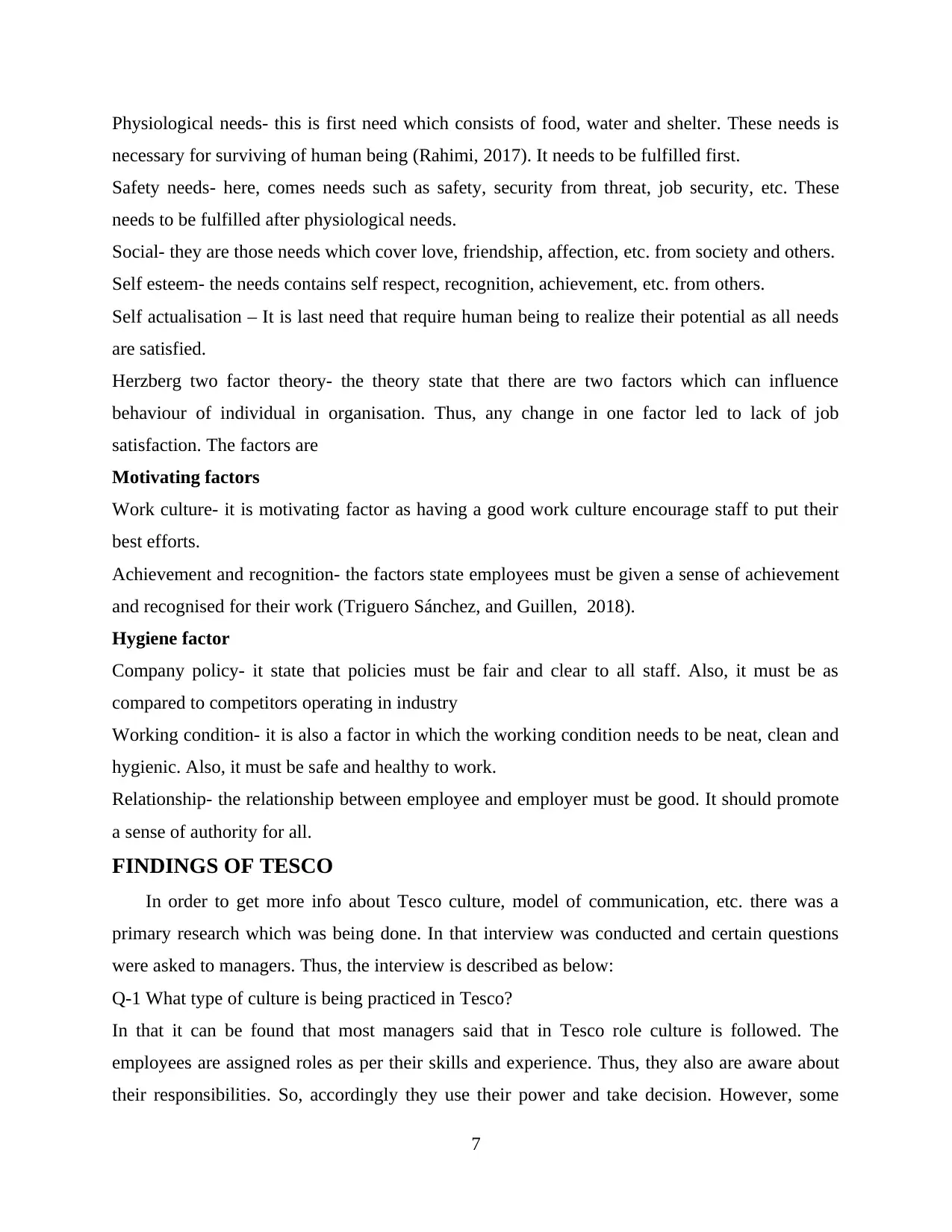
Physiological needs- this is first need which consists of food, water and shelter. These needs is
necessary for surviving of human being (Rahimi, 2017). It needs to be fulfilled first.
Safety needs- here, comes needs such as safety, security from threat, job security, etc. These
needs to be fulfilled after physiological needs.
Social- they are those needs which cover love, friendship, affection, etc. from society and others.
Self esteem- the needs contains self respect, recognition, achievement, etc. from others.
Self actualisation – It is last need that require human being to realize their potential as all needs
are satisfied.
Herzberg two factor theory- the theory state that there are two factors which can influence
behaviour of individual in organisation. Thus, any change in one factor led to lack of job
satisfaction. The factors are
Motivating factors
Work culture- it is motivating factor as having a good work culture encourage staff to put their
best efforts.
Achievement and recognition- the factors state employees must be given a sense of achievement
and recognised for their work (Triguero Sánchez, and Guillen, 2018).
Hygiene factor
Company policy- it state that policies must be fair and clear to all staff. Also, it must be as
compared to competitors operating in industry
Working condition- it is also a factor in which the working condition needs to be neat, clean and
hygienic. Also, it must be safe and healthy to work.
Relationship- the relationship between employee and employer must be good. It should promote
a sense of authority for all.
FINDINGS OF TESCO
In order to get more info about Tesco culture, model of communication, etc. there was a
primary research which was being done. In that interview was conducted and certain questions
were asked to managers. Thus, the interview is described as below:
Q-1 What type of culture is being practiced in Tesco?
In that it can be found that most managers said that in Tesco role culture is followed. The
employees are assigned roles as per their skills and experience. Thus, they also are aware about
their responsibilities. So, accordingly they use their power and take decision. However, some
7
necessary for surviving of human being (Rahimi, 2017). It needs to be fulfilled first.
Safety needs- here, comes needs such as safety, security from threat, job security, etc. These
needs to be fulfilled after physiological needs.
Social- they are those needs which cover love, friendship, affection, etc. from society and others.
Self esteem- the needs contains self respect, recognition, achievement, etc. from others.
Self actualisation – It is last need that require human being to realize their potential as all needs
are satisfied.
Herzberg two factor theory- the theory state that there are two factors which can influence
behaviour of individual in organisation. Thus, any change in one factor led to lack of job
satisfaction. The factors are
Motivating factors
Work culture- it is motivating factor as having a good work culture encourage staff to put their
best efforts.
Achievement and recognition- the factors state employees must be given a sense of achievement
and recognised for their work (Triguero Sánchez, and Guillen, 2018).
Hygiene factor
Company policy- it state that policies must be fair and clear to all staff. Also, it must be as
compared to competitors operating in industry
Working condition- it is also a factor in which the working condition needs to be neat, clean and
hygienic. Also, it must be safe and healthy to work.
Relationship- the relationship between employee and employer must be good. It should promote
a sense of authority for all.
FINDINGS OF TESCO
In order to get more info about Tesco culture, model of communication, etc. there was a
primary research which was being done. In that interview was conducted and certain questions
were asked to managers. Thus, the interview is described as below:
Q-1 What type of culture is being practiced in Tesco?
In that it can be found that most managers said that in Tesco role culture is followed. The
employees are assigned roles as per their skills and experience. Thus, they also are aware about
their responsibilities. So, accordingly they use their power and take decision. However, some
7
Paraphrase This Document
Need a fresh take? Get an instant paraphrase of this document with our AI Paraphraser
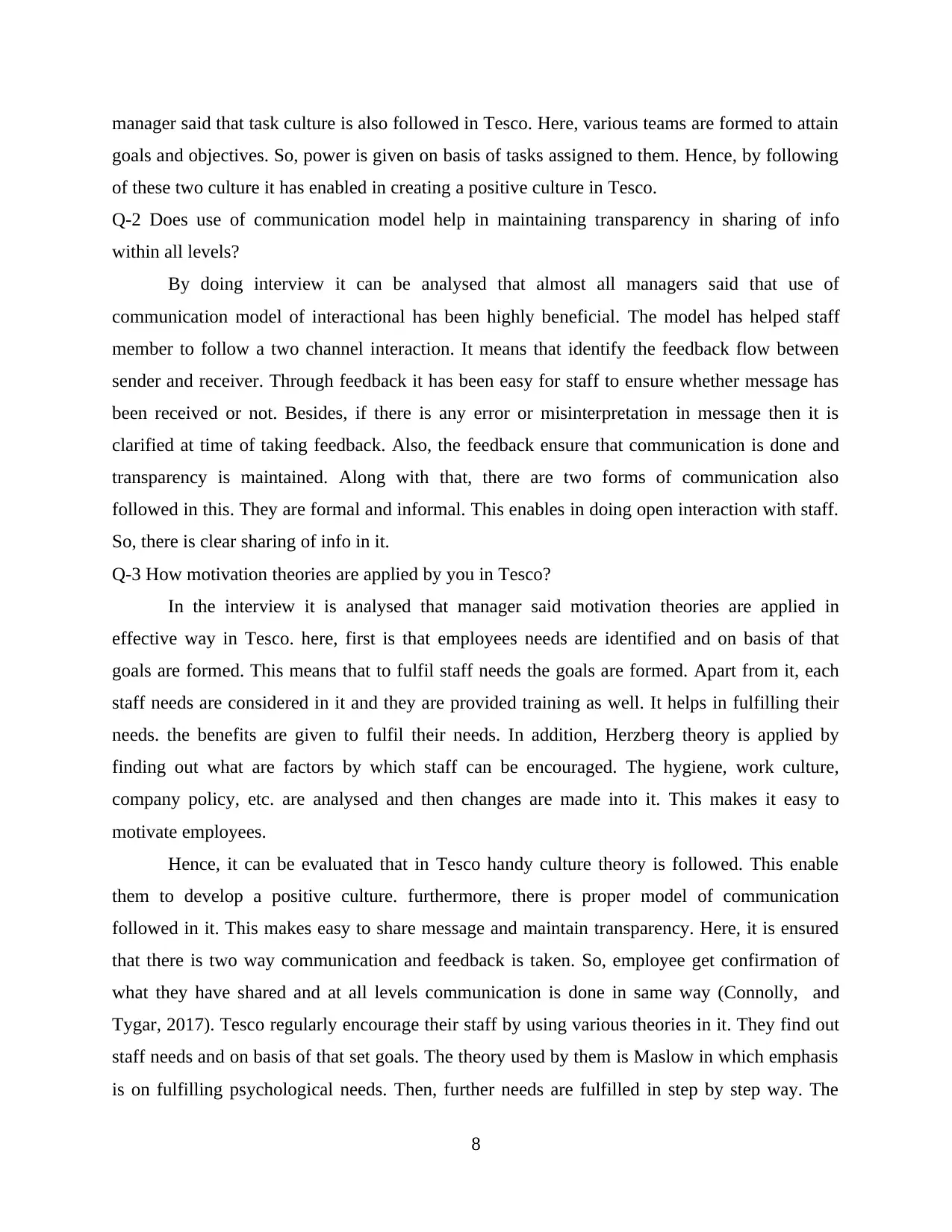
manager said that task culture is also followed in Tesco. Here, various teams are formed to attain
goals and objectives. So, power is given on basis of tasks assigned to them. Hence, by following
of these two culture it has enabled in creating a positive culture in Tesco.
Q-2 Does use of communication model help in maintaining transparency in sharing of info
within all levels?
By doing interview it can be analysed that almost all managers said that use of
communication model of interactional has been highly beneficial. The model has helped staff
member to follow a two channel interaction. It means that identify the feedback flow between
sender and receiver. Through feedback it has been easy for staff to ensure whether message has
been received or not. Besides, if there is any error or misinterpretation in message then it is
clarified at time of taking feedback. Also, the feedback ensure that communication is done and
transparency is maintained. Along with that, there are two forms of communication also
followed in this. They are formal and informal. This enables in doing open interaction with staff.
So, there is clear sharing of info in it.
Q-3 How motivation theories are applied by you in Tesco?
In the interview it is analysed that manager said motivation theories are applied in
effective way in Tesco. here, first is that employees needs are identified and on basis of that
goals are formed. This means that to fulfil staff needs the goals are formed. Apart from it, each
staff needs are considered in it and they are provided training as well. It helps in fulfilling their
needs. the benefits are given to fulfil their needs. In addition, Herzberg theory is applied by
finding out what are factors by which staff can be encouraged. The hygiene, work culture,
company policy, etc. are analysed and then changes are made into it. This makes it easy to
motivate employees.
Hence, it can be evaluated that in Tesco handy culture theory is followed. This enable
them to develop a positive culture. furthermore, there is proper model of communication
followed in it. This makes easy to share message and maintain transparency. Here, it is ensured
that there is two way communication and feedback is taken. So, employee get confirmation of
what they have shared and at all levels communication is done in same way (Connolly, and
Tygar, 2017). Tesco regularly encourage their staff by using various theories in it. They find out
staff needs and on basis of that set goals. The theory used by them is Maslow in which emphasis
is on fulfilling psychological needs. Then, further needs are fulfilled in step by step way. The
8
goals and objectives. So, power is given on basis of tasks assigned to them. Hence, by following
of these two culture it has enabled in creating a positive culture in Tesco.
Q-2 Does use of communication model help in maintaining transparency in sharing of info
within all levels?
By doing interview it can be analysed that almost all managers said that use of
communication model of interactional has been highly beneficial. The model has helped staff
member to follow a two channel interaction. It means that identify the feedback flow between
sender and receiver. Through feedback it has been easy for staff to ensure whether message has
been received or not. Besides, if there is any error or misinterpretation in message then it is
clarified at time of taking feedback. Also, the feedback ensure that communication is done and
transparency is maintained. Along with that, there are two forms of communication also
followed in this. They are formal and informal. This enables in doing open interaction with staff.
So, there is clear sharing of info in it.
Q-3 How motivation theories are applied by you in Tesco?
In the interview it is analysed that manager said motivation theories are applied in
effective way in Tesco. here, first is that employees needs are identified and on basis of that
goals are formed. This means that to fulfil staff needs the goals are formed. Apart from it, each
staff needs are considered in it and they are provided training as well. It helps in fulfilling their
needs. the benefits are given to fulfil their needs. In addition, Herzberg theory is applied by
finding out what are factors by which staff can be encouraged. The hygiene, work culture,
company policy, etc. are analysed and then changes are made into it. This makes it easy to
motivate employees.
Hence, it can be evaluated that in Tesco handy culture theory is followed. This enable
them to develop a positive culture. furthermore, there is proper model of communication
followed in it. This makes easy to share message and maintain transparency. Here, it is ensured
that there is two way communication and feedback is taken. So, employee get confirmation of
what they have shared and at all levels communication is done in same way (Connolly, and
Tygar, 2017). Tesco regularly encourage their staff by using various theories in it. They find out
staff needs and on basis of that set goals. The theory used by them is Maslow in which emphasis
is on fulfilling psychological needs. Then, further needs are fulfilled in step by step way. The
8
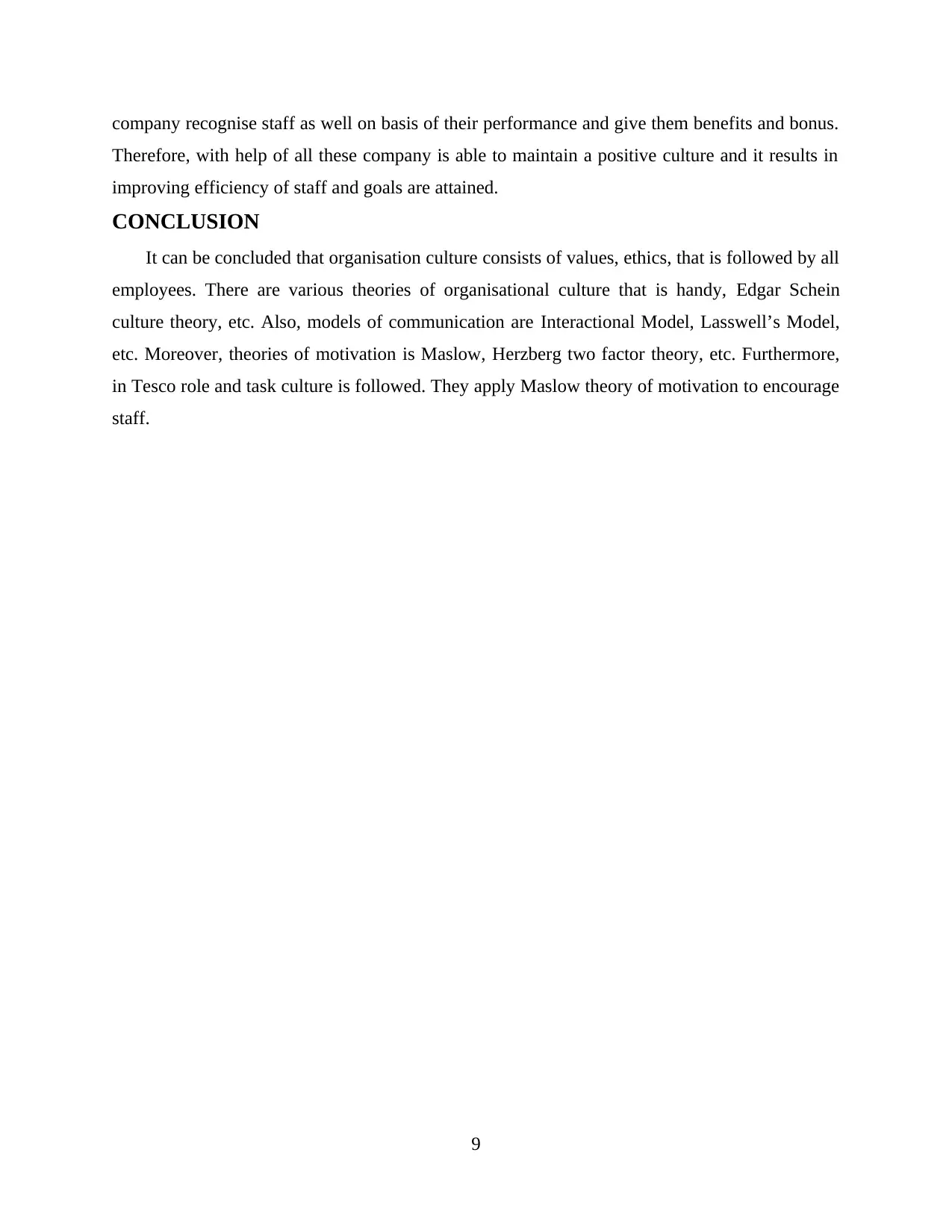
company recognise staff as well on basis of their performance and give them benefits and bonus.
Therefore, with help of all these company is able to maintain a positive culture and it results in
improving efficiency of staff and goals are attained.
CONCLUSION
It can be concluded that organisation culture consists of values, ethics, that is followed by all
employees. There are various theories of organisational culture that is handy, Edgar Schein
culture theory, etc. Also, models of communication are Interactional Model, Lasswell’s Model,
etc. Moreover, theories of motivation is Maslow, Herzberg two factor theory, etc. Furthermore,
in Tesco role and task culture is followed. They apply Maslow theory of motivation to encourage
staff.
9
Therefore, with help of all these company is able to maintain a positive culture and it results in
improving efficiency of staff and goals are attained.
CONCLUSION
It can be concluded that organisation culture consists of values, ethics, that is followed by all
employees. There are various theories of organisational culture that is handy, Edgar Schein
culture theory, etc. Also, models of communication are Interactional Model, Lasswell’s Model,
etc. Moreover, theories of motivation is Maslow, Herzberg two factor theory, etc. Furthermore,
in Tesco role and task culture is followed. They apply Maslow theory of motivation to encourage
staff.
9
⊘ This is a preview!⊘
Do you want full access?
Subscribe today to unlock all pages.

Trusted by 1+ million students worldwide
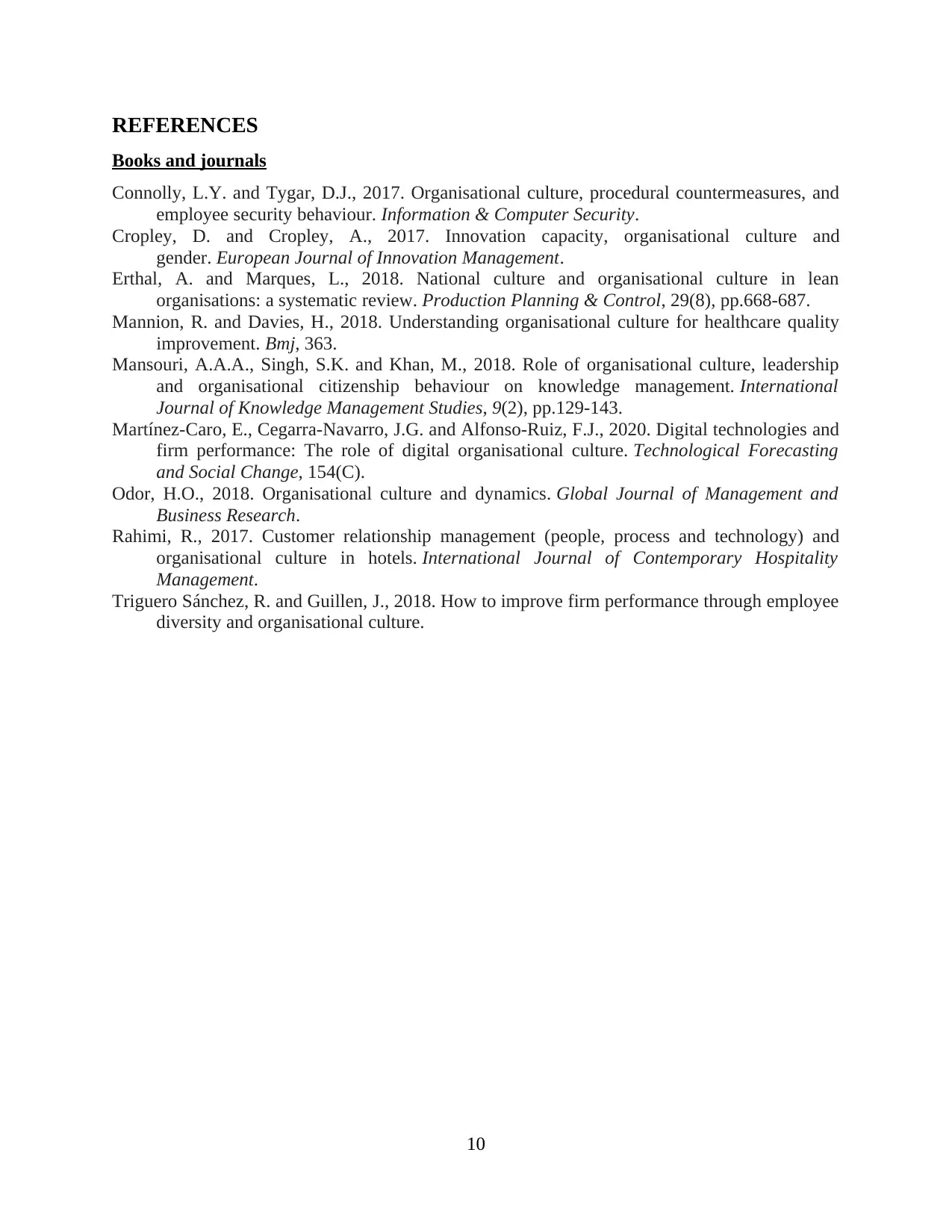
REFERENCES
Books and journals
Connolly, L.Y. and Tygar, D.J., 2017. Organisational culture, procedural countermeasures, and
employee security behaviour. Information & Computer Security.
Cropley, D. and Cropley, A., 2017. Innovation capacity, organisational culture and
gender. European Journal of Innovation Management.
Erthal, A. and Marques, L., 2018. National culture and organisational culture in lean
organisations: a systematic review. Production Planning & Control, 29(8), pp.668-687.
Mannion, R. and Davies, H., 2018. Understanding organisational culture for healthcare quality
improvement. Bmj, 363.
Mansouri, A.A.A., Singh, S.K. and Khan, M., 2018. Role of organisational culture, leadership
and organisational citizenship behaviour on knowledge management. International
Journal of Knowledge Management Studies, 9(2), pp.129-143.
Martínez-Caro, E., Cegarra-Navarro, J.G. and Alfonso-Ruiz, F.J., 2020. Digital technologies and
firm performance: The role of digital organisational culture. Technological Forecasting
and Social Change, 154(C).
Odor, H.O., 2018. Organisational culture and dynamics. Global Journal of Management and
Business Research.
Rahimi, R., 2017. Customer relationship management (people, process and technology) and
organisational culture in hotels. International Journal of Contemporary Hospitality
Management.
Triguero Sánchez, R. and Guillen, J., 2018. How to improve firm performance through employee
diversity and organisational culture.
10
Books and journals
Connolly, L.Y. and Tygar, D.J., 2017. Organisational culture, procedural countermeasures, and
employee security behaviour. Information & Computer Security.
Cropley, D. and Cropley, A., 2017. Innovation capacity, organisational culture and
gender. European Journal of Innovation Management.
Erthal, A. and Marques, L., 2018. National culture and organisational culture in lean
organisations: a systematic review. Production Planning & Control, 29(8), pp.668-687.
Mannion, R. and Davies, H., 2018. Understanding organisational culture for healthcare quality
improvement. Bmj, 363.
Mansouri, A.A.A., Singh, S.K. and Khan, M., 2018. Role of organisational culture, leadership
and organisational citizenship behaviour on knowledge management. International
Journal of Knowledge Management Studies, 9(2), pp.129-143.
Martínez-Caro, E., Cegarra-Navarro, J.G. and Alfonso-Ruiz, F.J., 2020. Digital technologies and
firm performance: The role of digital organisational culture. Technological Forecasting
and Social Change, 154(C).
Odor, H.O., 2018. Organisational culture and dynamics. Global Journal of Management and
Business Research.
Rahimi, R., 2017. Customer relationship management (people, process and technology) and
organisational culture in hotels. International Journal of Contemporary Hospitality
Management.
Triguero Sánchez, R. and Guillen, J., 2018. How to improve firm performance through employee
diversity and organisational culture.
10
1 out of 10
Related Documents
Your All-in-One AI-Powered Toolkit for Academic Success.
+13062052269
info@desklib.com
Available 24*7 on WhatsApp / Email
![[object Object]](/_next/static/media/star-bottom.7253800d.svg)
Unlock your academic potential
Copyright © 2020–2025 A2Z Services. All Rights Reserved. Developed and managed by ZUCOL.





